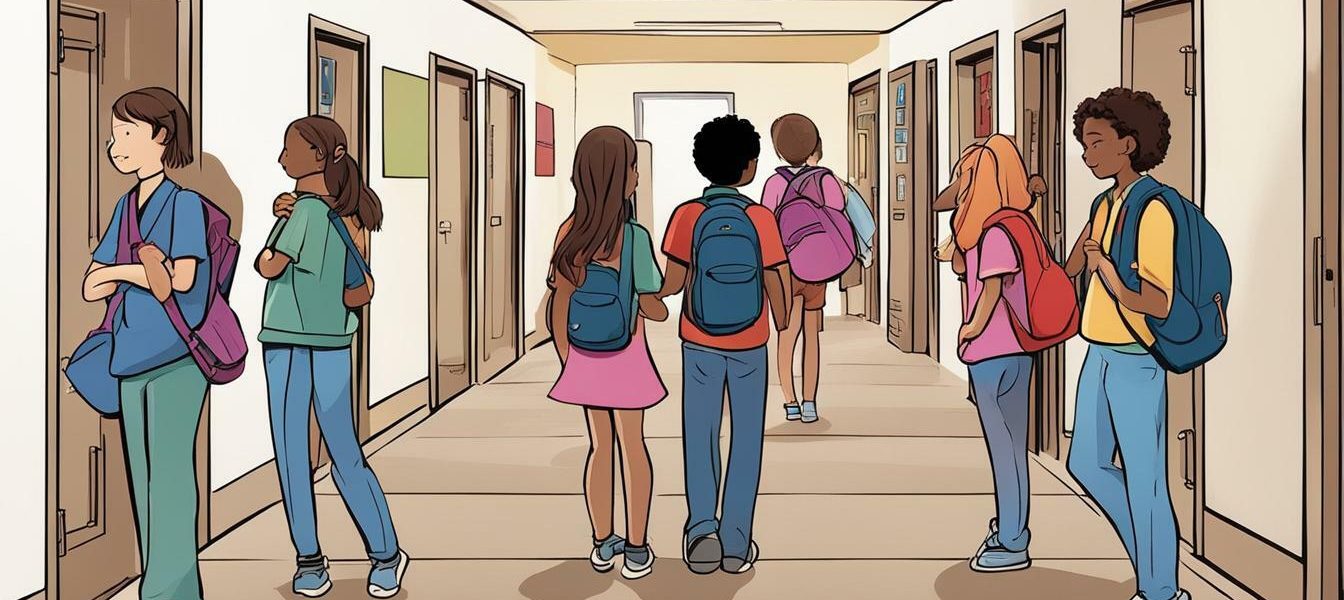
What Does PDA Mean In School?
Public Display of Affection, or PDA, is a term used to describe physical affection between individuals in public spaces. In school settings, PDA can range from holding hands to kissing, and can sometimes be a distraction from learning.
Key Takeaways
- PDA stands for Public Display of Affection.
- PDA in school settings can be distracting from learning.
- Examples of PDA in schools can include holding hands, hugging, and kissing.
Understanding PDA: Definition and Explanation
Public Display of Affection (PDA) is a term used to describe the physical expressions of intimacy between two people in a public setting. In the context of schools, PDA refers to any type of intimate physical behavior among students that is not appropriate or acceptable in a classroom setting.
Some of the common forms of PDA in schools include holding hands, hugging, kissing, and even sexually suggestive behavior. While these actions may seem harmless to some, they can create an uncomfortable or distracting atmosphere for other students and teachers.
It’s essential to understand that PDA can take different forms and can be interpreted differently by different people. While some students may see holding hands as a harmless display of affection, others may find it inappropriate and uncomfortable.
Defining PDA in School Settings
When it comes to schools, PDA is defined as any physical behavior that is not appropriate or acceptable in a educational setting. The appropriateness of a particular behavior is determined by the school’s code of conduct, cultural norms, and the opinions of teachers, students, and parents.
It’s important to note that what is considered appropriate and acceptable PDA behavior can vary depending on the context of the situation. For example, PDA behavior that is appropriate and acceptable at a school dance may not be appropriate or acceptable in a classroom setting.
While the definition of PDA may vary, it’s important to establish clear and consistent guidelines for students that outline what is and isn’t acceptable behavior. By doing so, schools can create a safe and respectful learning environment for all students.
Common Forms of PDA in Schools
Public Display of Affection (PDA) in schools can take on various forms. Some common examples include:
| Type of PDA | Description | Appropriateness in schools |
|---|---|---|
| Holding hands | When two students interlock hands while walking or sitting. | Generally considered appropriate, but can become distracting if done excessively or inappropriately. |
| Hugging | When two students embrace in a tight or loose hug. | Can be appropriate as a friendly gesture, but may become inappropriate if it turns into an extended embrace or becomes too intimate in nature. |
| Kissing | When two students engage in a brief or prolonged lip-lock. | Generally not considered appropriate and can be disruptive to the learning environment. Schools often prohibit kissing on campus. |
It is important to note that context can play a role in determining the appropriateness of PDA in schools. For example, hugging a friend to console them after receiving bad news may be more acceptable than engaging in a prolonged embrace with a romantic partner during class.
School Policies on PDA
Many schools have established policies regarding public displays of affection (PDA) in an effort to maintain a professional and respectful learning environment. Such policies can vary between schools, but generally aim to ensure that students feel comfortable and safe while attending school.
Some schools may prohibit all forms of PDA, while others may allow certain types of non-disruptive behavior such as hand-holding, but prohibit more intimate displays such as kissing. These policies are typically communicated to students through school handbooks or codes of conduct.
The reasons behind these policies are often rooted in the need to provide a safe and inclusive learning environment for all students. PDA can be distracting to other students and can make some individuals feel uncomfortable or uneasy. Additionally, excessive displays of PDA may lead to a culture of peer pressure or unhealthy competitiveness among students.
Effects of PDA on Students and the Academic Environment
While many students engage in PDA as a way to express their affection for each other, these behaviors can have negative effects on both students and the academic environment. Excessive PDA can cause distractions and disruptions, making it difficult for other students to focus and learn. Furthermore, certain forms of PDA, such as groping or sexual activity, are completely inappropriate in an educational setting and can lead to disciplinary action or even legal repercussions.
Moreover, excessive PDA can lead to negative emotional effects on students. It can make students feel uncomfortable or even embarrassed, particularly if they are not comfortable with displaying affection in public. This can lead to a loss of self-esteem and can impact academic performance. It can also create an environment that is not inclusive for students who do not engage in PDA or those who identify as LGBTQ+.
Therefore, it is important for schools to have clear policies and guidelines regarding appropriate behavior in school settings, including PDA. Teachers and school administrators must work to create an environment that is both supportive of healthy relationships and respectful of individual boundaries and the need for a professional academic environment.
Addressing PDA: Educating Students and Parents
One effective way to address PDA is through educating both students and parents. It is essential to stress the importance of respecting personal boundaries and maintaining a professional academic environment. Parents can help reinforce these values at home, while schools provide educational programs and resources that promote appropriate behavior in school settings.
Teachers can also play a crucial role in educating students about PDA. By creating a supportive and inclusive classroom environment, teachers can encourage healthy relationships that do not rely solely on physical displays of affection. Teachers can also provide guidance on how to express affection in respectful and appropriate ways.
Alternatives to PDA: Building Healthy Relationships
While it’s natural for students to want to show affection to their friends and partners, it’s important to find alternatives to excessive PDA that can make others uncomfortable or disrupt the learning environment. Here are some ideas for building healthy relationships that balance personal expression with respect for school rules:
- Verbal Affirmations: Instead of physical displays of affection, try expressing your feelings and appreciation with words. A simple “thank you,” “I appreciate you,” or “you’re a great friend” can go a long way in strengthening your relationships.
- Acts of Kindness: A thoughtful gesture, such as offering to help with homework or holding the door open for someone, can be just as meaningful as a hug or kiss.
- Group Activities: Participating in group activities, such as sports teams or clubs, can be a great way to bond with friends and meet new people without relying on physical touch.
- Creative Outlets: Express your affection through creative outlets, such as making a friendship bracelet, drawing a picture, or writing a poem.
Remember, building healthy relationships is about respecting boundaries and finding ways to show you care that everyone is comfortable with. By exploring alternatives to excessive PDA, you can create a more inclusive school environment that values everyone’s well-being.
Peer Pressure and PDA
It’s no secret that peer pressure plays a significant role in many students’ lives, including their behavior regarding PDA. Societal norms and media influence can create pressure for students to engage in physical displays of affection, even if it’s not necessarily their personal preference or comfort level.
As educators and parents, it’s essential to be aware of the influence of peer pressure on students and to encourage them to make decisions based on their personal values and beliefs rather than external pressures.
Balancing Personal Expression and School Rules
As students navigate the complexities of school policies on PDA, it is essential to find a balance between personal expressive and respect for school rules. At times, this balance can be challenging to achieve, especially when students feel that their rights to personal expression are being curtailed.
However, it is essential to recognize that school policies on PDA are in place for a reason. Although it may be tempting to disregard them, doing so can have negative consequences on the learning environment and the school community. Therefore, it is crucial to respect these policies while still finding ways to express oneself in a positive and appropriate manner.
“It’s important to remember that your actions can impact others,” – Emma Smith, School Counselor.
One way to do this is by fostering healthy relationships and friendships that do not rely solely on physical displays of affection. Students can express their affection for one another through engaging in shared interests, having meaningful conversations, and showing kindness and support. Encouraging positive behaviors can also help create a supportive and inclusive school environment.
Moreover, it is necessary to respect personal boundaries and understand that not everyone feels comfortable with PDA. A simple hand gesture, a friendly smile, or a nod of the head can be just as meaningful as a hug or a kiss. Respecting personal boundaries is an essential aspect of fostering healthy and respectful relationships.
“By building relationships based on mutual respect and understanding, students can balance their personal expression with school rules,” – Michael Jones, Educational Psychologist.
Ultimately, finding a balance between personal expression and school rules requires a shift in mindset, one that prioritizes respect and inclusivity over individual desires. By doing so, students can create a positive learning environment that supports their academic and personal growth.
Teachers’ Role in Addressing PDA
Teachers play a crucial role in addressing PDA in schools. They are responsible for creating a safe and supportive learning environment that promotes respect and professionalism. Here are some suggestions for how teachers can address PDA:
- Set clear expectations: Teachers should establish clear expectations for appropriate behavior in the classroom and communicate them to students and parents. This can include a discussion of school policies on PDA and the reasons behind them.
- Enforce policies consistently: Teachers should enforce school policies on PDA consistently and fairly. This can help to create a sense of accountability and discourage students from engaging in excessive PDA.
- Be approachable: Teachers should be approachable and open to discussing PDA with students. This can help to foster a sense of trust and encourage students to seek guidance when they are unsure about appropriate behavior.
- Encourage healthy relationships: Teachers can encourage students to develop healthy relationships with one another that are based on mutual respect, trust, and communication. This can help to reduce the reliance on physical displays of affection as a way of expressing affection.
By taking a proactive approach to addressing PDA in schools, teachers can help to create a positive and inclusive learning environment that promotes respect and professionalism.
Conclusion
Public Display of Affection (PDA) in schools has been a topic of controversy and concern for many educators, parents, and students. While physical displays of affection can be a natural part of human interaction, they can also disrupt the learning environment and cause discomfort for others.
Through this article, we have explored the various forms of PDA in schools, as well as the existing policies and regulations regarding this behavior. We have also discussed the potential effects of excessive PDA on students’ emotional well-being, self-esteem, and academic performance.
It is crucial that students, parents, and educators work together to create a learning environment that balances personal expression and respect for school rules. By educating students and parents about appropriate behavior in schools and encouraging healthy relationships, we can help prevent excessive PDA and create a more supportive and inclusive classroom environment.
As teachers, it is important to remember our role in addressing PDA in schools. By leading by example, creating a safe and respectful classroom environment, and enforcing school policies in a fair and consistent way, we can help our students thrive academically and emotionally.
Let us work together to create a positive learning environment that promotes personal expression, healthy relationships, and respect for school rules.



